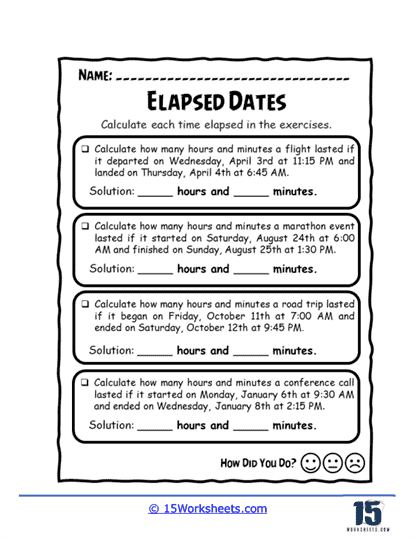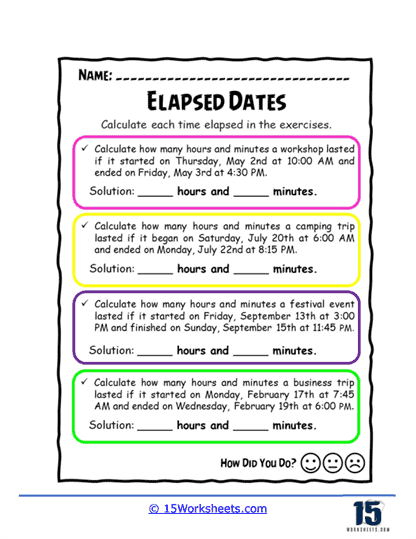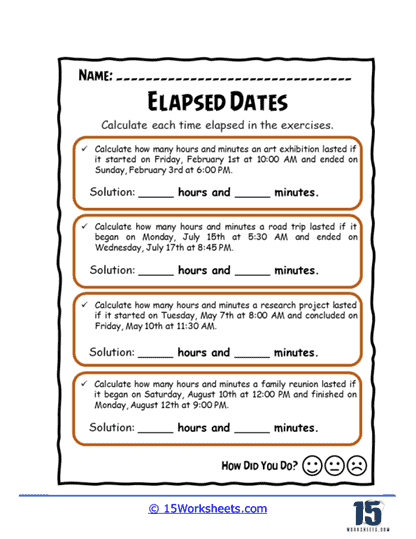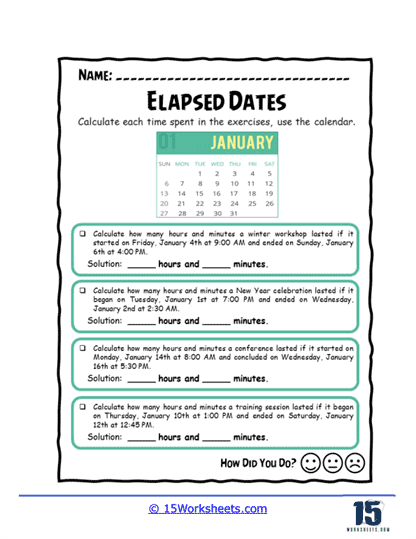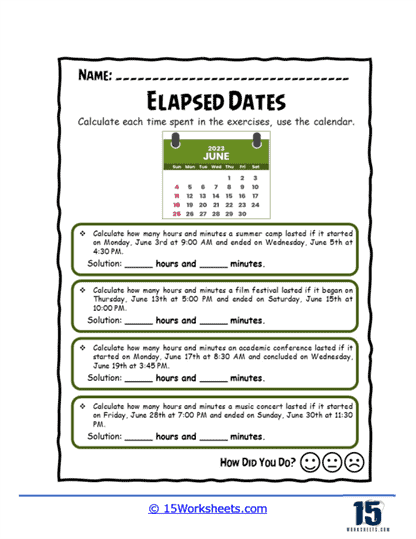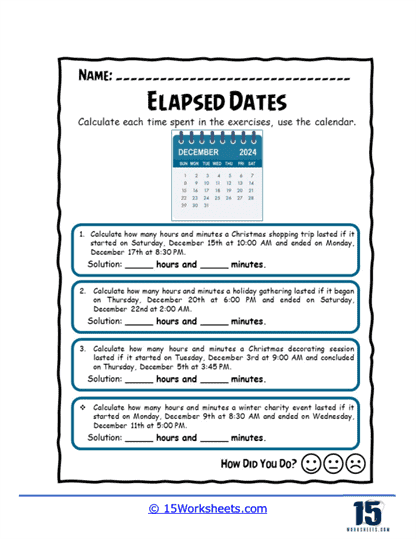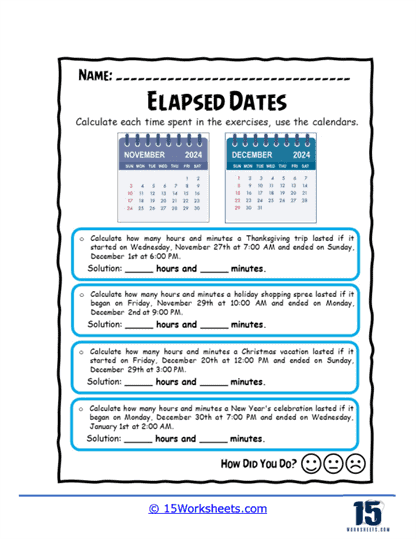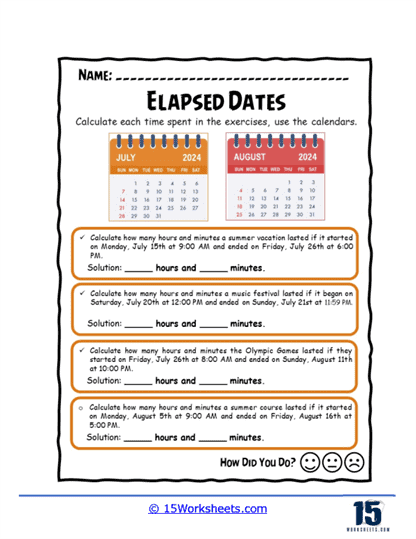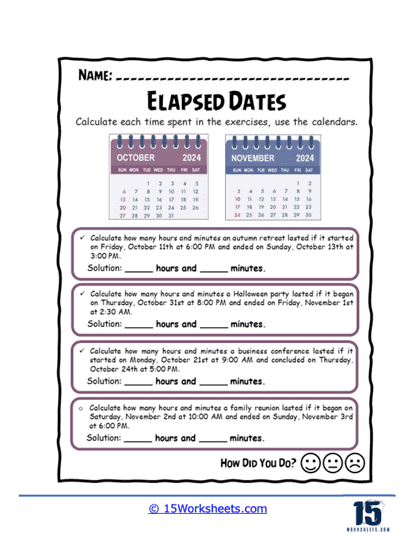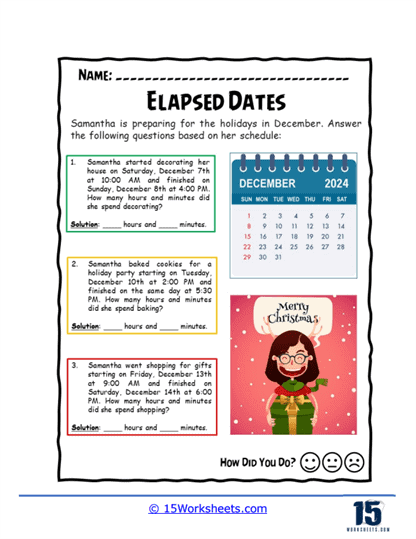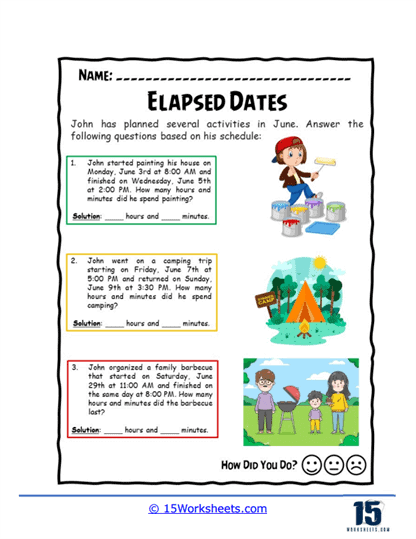Elapsed Time Worksheets
About These 15 Worksheets
These worksheets were designed to help students understand and calculate the amount of time that has passed between a start time and an end time. These worksheets typically present scenarios where students must determine how much time has elapsed by analyzing given start and end times. The primary goal is to enhance students’ time management skills and their understanding of the passage of time, which is crucial in daily life and various professional fields.
These worksheets are commonly used in elementary and middle school classrooms as part of the math curriculum. They provide practical and engaging ways for students to apply their mathematical knowledge to real-life situations. Elapsed time worksheets are not just about practicing arithmetic; they also help students develop critical thinking and problem-solving skills as they assess and compare different time intervals.
The Math Skills Explored
These worksheets cover several essential math skills, making them a valuable educational resource. One of the primary skills is basic arithmetic, as students must add, subtract, and compare times. For example, they might need to add the time it takes to complete multiple tasks to determine a total duration or subtract a start time from an end time to find the elapsed time. These exercises reinforce addition and subtraction skills, which are foundational in math education.
Another critical skill is the ability to understand and work with units of time. Students must be able to differentiate between hours and minutes and know how to convert between these units when necessary. This understanding is crucial for various real-world applications, such as scheduling and time management.
These types of activities encourage students to develop their estimation skills. Estimation is a vital skill in math and everyday life, allowing individuals to make quick, reasonable guesses when precise measurements are not necessary or available. By practicing estimation, students become more confident in their ability to judge durations and make informed decisions.
Exercises on These Worksheets
One common type of exercise on these worksheets involves straightforward problems where students are given a start time and an end time and are required to calculate the elapsed time between them. For example, a problem might ask students to determine how many hours and minutes have passed between 9:15 AM and 11:45 AM. These exercises help students practice basic subtraction of time and reinforce their understanding of how hours and minutes work together.
Another type of problem involves scenarios where students must add a specified amount of time to a given start time to find the end time. For instance, a worksheet might state that a movie starts at 2:30 PM and lasts for 1 hour and 45 minutes, asking students to determine what time the movie ends. This type of exercise requires students to perform addition with time, often carrying over minutes into hours, thus enhancing their arithmetic skills and understanding of time increments.
They also include problems that involve calculating elapsed time across different periods of the day, such as spanning from AM to PM or across midnight. For example, students might be asked to find the elapsed time between 10:30 PM and 1:15 AM. These problems challenge students to understand the 24-hour clock and how to navigate the transition between different periods of the day, reinforcing concepts related to the full day cycle.
More advanced exercises might incorporate word problems that place elapsed time calculations within real-world contexts. These scenarios could involve planning events, scheduling activities, or determining the duration of trips. For instance, a word problem might describe a school day starting at 8:00 AM and ending at 3:00 PM, with various breaks included, and ask students to calculate the total instructional time. These problems help students see the practical applications of their skills and improve their ability to solve problems they might encounter in everyday life.
The Benefits Of These Worksheets
Learning how to determine elapsed time provides numerous benefits, particularly in enhancing mathematical comprehension and practical life skills. One significant advantage is the improvement of arithmetic abilities. Calculating elapsed time involves addition and subtraction of hours and minutes, and sometimes seconds. These calculations often require carrying over minutes to hours or vice versa, reinforcing students’ understanding of place value and enhancing their overall arithmetic skills. Additionally, working with elapsed time helps students grasp the concept of time intervals and units of measurement, which are fundamental mathematical concepts.
Another benefit is the enhancement of problem-solving and critical thinking skills. Determining elapsed time often involves multi-step problems, especially when it includes crossing over from AM to PM or spanning multiple days. These scenarios require students to break down the problem into manageable parts, apply logical reasoning, and perform sequential calculations. Such exercises improve students’ ability to approach complex problems methodically and develop strong analytical skills.
Learning to determine elapsed time fosters better time management and organizational skills. Students who can accurately calculate how much time has passed or how much time is needed for a task are better equipped to plan their activities effectively. This skill is crucial for managing study schedules, balancing extracurricular activities, and meeting deadlines. By understanding elapsed time, students can prioritize tasks and allocate appropriate amounts of time to different activities, leading to more efficient and productive use of their time.
Real World Application Of This Skill
In the real world, the ability to determine elapsed time is indispensable in various contexts. One of the most common applications is in daily scheduling and planning. Whether it is calculating the duration of a commute, the length of a meeting, or the time required to complete a project, understanding elapsed time helps individuals manage their day-to-day activities efficiently. For instance, knowing how long a meeting will last allows a person to schedule subsequent appointments appropriately, ensuring punctuality and effective time management.
In professional settings, determining elapsed time is crucial for project management and productivity tracking. Project managers often need to estimate the time required to complete different phases of a project, monitor progress, and adjust schedules accordingly. Accurate time tracking helps in setting realistic deadlines, allocating resources efficiently, and identifying any delays or bottlenecks in the workflow. In fields such as manufacturing, healthcare, and logistics, precise time calculations are essential for optimizing operations and ensuring timely delivery of services and products.
In the realm of travel and transportation, understanding elapsed time is vital for planning journeys and coordinating schedules. Travelers need to calculate the duration of flights, train rides, or road trips to make connections, book accommodations, and plan activities at their destination. Transport operators use elapsed time calculations to create timetables, manage departures and arrivals, and maintain efficient service operations. For example, airlines rely on precise time management to ensure flights depart and arrive on schedule, minimizing delays and enhancing customer satisfaction.
Example Problem – Emma started reading her favorite book at 3:15 PM. She finished reading at 4:45 PM. How long did Emma spend reading her book?
Step-by-Step Solution
1. Identify the start and end times
– Start time: 3:15 PM
– End time: 4:45 PM
2. Break down the problem into simpler parts
– From 3:15 PM to 4:15 PM is 1 hour.
– From 4:15 PM to 4:45 PM is 30 minutes.
3. Add the time intervals together
Total time spent reading = 1 hour + 30 minutes
4. Combine the hours and minutes
1 hour + 30 minutes = 1 hour and 30 minutes


